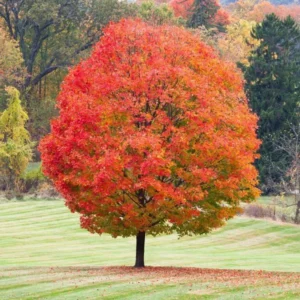Description
Lilac Tree (Syringa Vulgaris) – 1 Yr Old Seedling
Overview
The Lilac Tree (Syringa vulgaris) is a beloved ornamental tree celebrated for its lush, fragrant blossoms and vibrant springtime display. Known for its clusters of purple, pink, or white flowers, the Lilac tree adds charm and elegance to any garden or landscape. This 1-year-old seedling offers a perfect opportunity to grow your own fragrant centerpiece. Ideal for small gardens, mixed borders, or as a single specimen tree.
Native Range
Originally native to southeastern Europe, Lilac trees have become a favorite in North American gardens, thriving in temperate regions.
Growth and Form
- Height: Reaches 12–15 feet at maturity, depending on conditions.
- Spread: Grows with a rounded shape, spreading 10–12 feet wide.
- Growth Rate: Moderate, with 12–24 inches of growth per year under optimal conditions.
- Foliage: Heart-shaped, dark green leaves that serve as an attractive backdrop to the vibrant flowers.
- Flowers: Dense, conical clusters of highly fragrant blooms appear in late spring, varying in color from purple to pink and white.
Ecological Benefits
- Pollinator Attraction: The fragrant blooms attract bees, butterflies, and other pollinators, making the Lilac tree an excellent choice for supporting local ecosystems.
- Bird Habitat: Birds appreciate the dense foliage for shelter and nesting.
- Aromatic Benefits: Lilac’s intoxicating fragrance adds to the sensory appeal of your garden space.
Hardiness and Climate Tolerance
- Hardiness Zones: 3–7, making it adaptable to a wide range of climates.
- Cold Tolerance: Extremely hardy, tolerating cold temperatures as low as -40°F (-40°C).
- Drought Tolerance: Lilacs are moderately drought-tolerant once established but perform best with consistent watering.
- Soil Preferences: Prefers well-drained, slightly alkaline soil. Thrives in loamy soils with good drainage.
Planting and Care
- Planting Location: Lilacs prefer full sun for optimal flowering. Choose a site with good air circulation to minimize fungal issues.
- Watering: Water deeply during dry spells, especially in the first few years to establish a healthy root system.
- Fertilization: Use a balanced fertilizer in early spring to support healthy growth and blooms.
- Pruning: Prune immediately after flowering to shape the tree and encourage future blooms. Avoid pruning in late summer or fall, as this can remove next year’s flower buds.
Uses
- Ornamental: Lilacs are perfect for standalone specimen trees, hedges, or mixed garden borders.
- Cut Flowers: The blooms are popular in floral arrangements due to their fragrance and beauty.
- Fragrance: Adds a lovely, nostalgic scent to gardens, patios, and walkways.
Potential Problems
- Powdery Mildew: In humid conditions, Lilacs can develop powdery mildew. Ensure proper air circulation and use fungicides if necessary.
- Pest Issues: Occasional pests like borers may affect Lilacs, but regular maintenance and monitoring can prevent infestations.
- Non-Blooming: Poor flowering may occur if the tree is not receiving enough sunlight or if pruned incorrectly.






Reviews
There are no reviews yet.